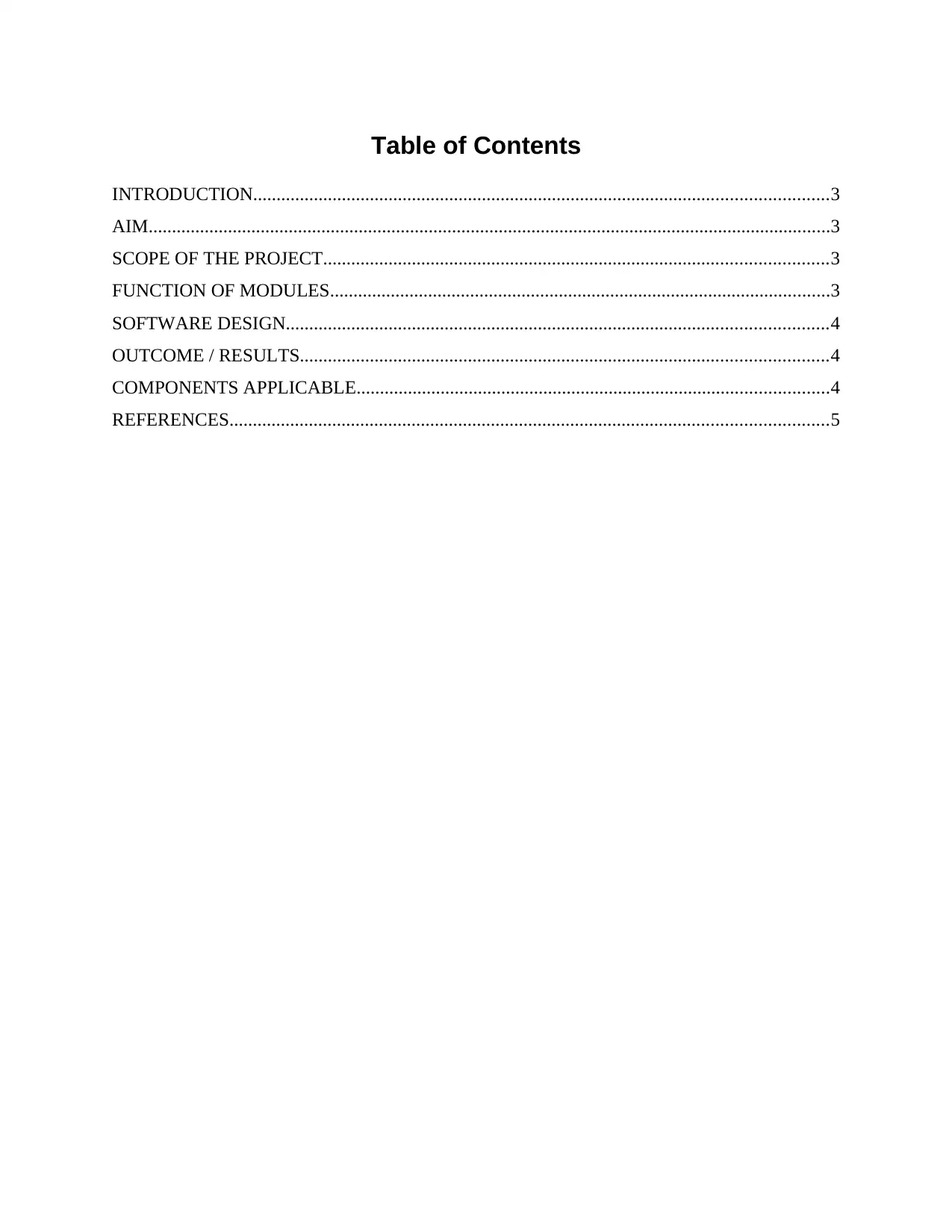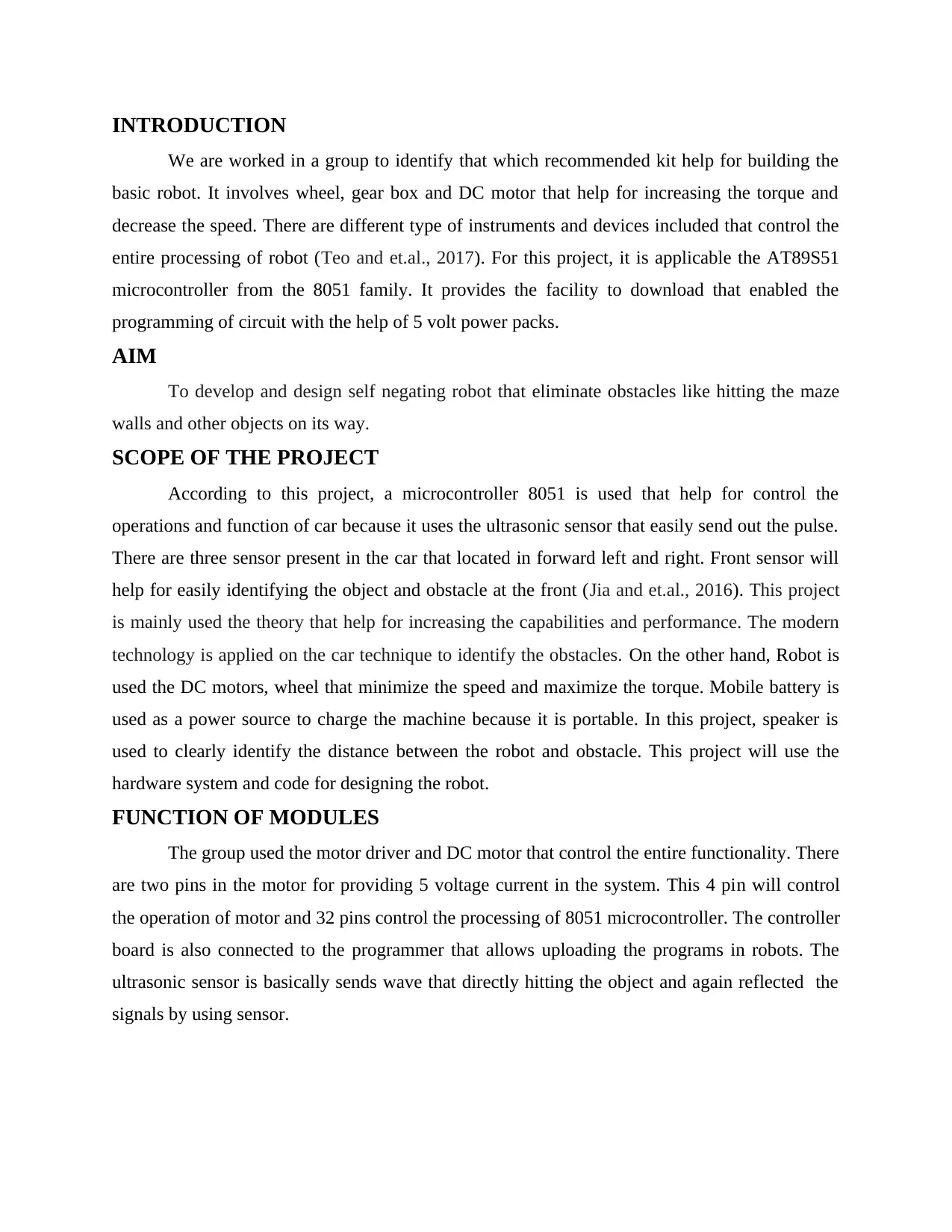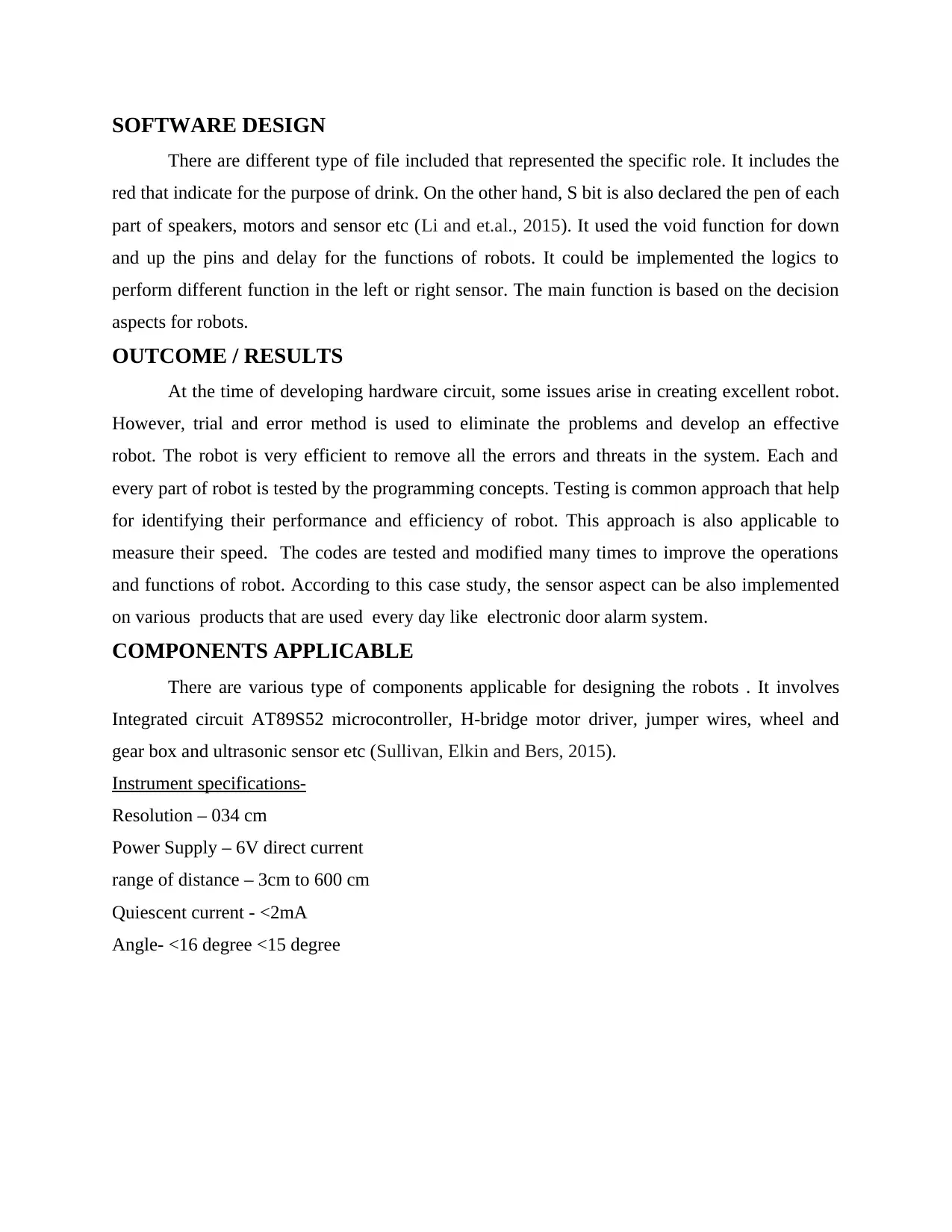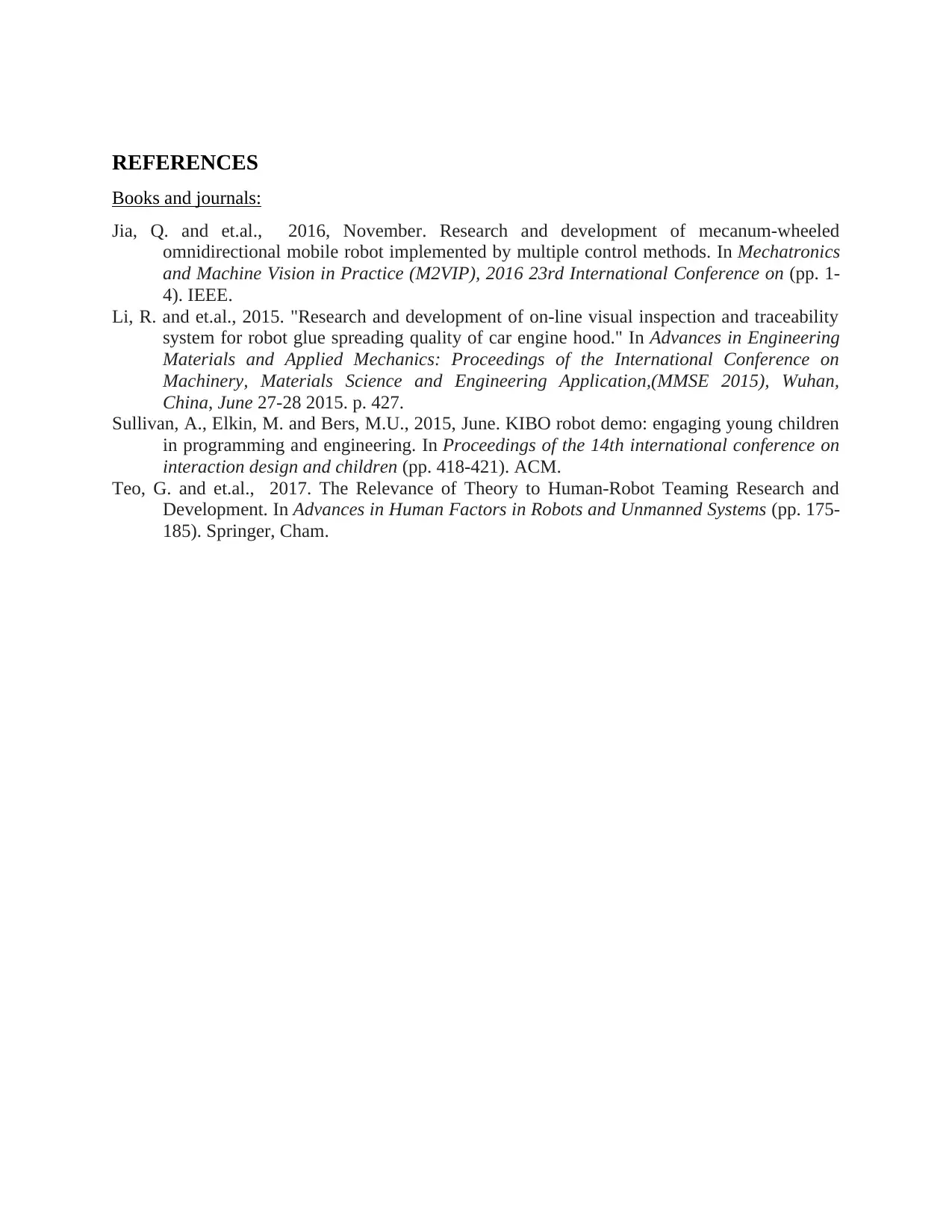Self-Negating Robot: Design, Development, and Implementation
VerifiedAdded on 2020/10/22
|6
|946
|164
Report
AI Summary
This report details the design and development of a self-negating robot, created to navigate and avoid obstacles. The project utilizes an AT89S51 microcontroller, ultrasonic sensors, DC motors, and a gearbox. The report outlines the project's aim, scope, and the function of various modules, including the motor driver and sensor system. The software design incorporates different files for various functions, including sensor readings and motor control, with void functions and delays used for precise control. The outcome of the project highlights the efficiency of the robot in eliminating errors, with each component tested and optimized through programming and testing. Applicable components include an integrated circuit, H-bridge motor driver, jumper wires, wheels, and an ultrasonic sensor. The project is supported by references to relevant research papers and books.

Paraphrasing
Paraphrase This Document
Need a fresh take? Get an instant paraphrase of this document with our AI Paraphraser

Table of Contents
INTRODUCTION...........................................................................................................................3
AIM..................................................................................................................................................3
SCOPE OF THE PROJECT............................................................................................................3
FUNCTION OF MODULES...........................................................................................................3
SOFTWARE DESIGN....................................................................................................................4
OUTCOME / RESULTS.................................................................................................................4
COMPONENTS APPLICABLE.....................................................................................................4
REFERENCES................................................................................................................................5
INTRODUCTION...........................................................................................................................3
AIM..................................................................................................................................................3
SCOPE OF THE PROJECT............................................................................................................3
FUNCTION OF MODULES...........................................................................................................3
SOFTWARE DESIGN....................................................................................................................4
OUTCOME / RESULTS.................................................................................................................4
COMPONENTS APPLICABLE.....................................................................................................4
REFERENCES................................................................................................................................5

INTRODUCTION
We are worked in a group to identify that which recommended kit help for building the
basic robot. It involves wheel, gear box and DC motor that help for increasing the torque and
decrease the speed. There are different type of instruments and devices included that control the
entire processing of robot (Teo and et.al., 2017). For this project, it is applicable the AT89S51
microcontroller from the 8051 family. It provides the facility to download that enabled the
programming of circuit with the help of 5 volt power packs.
AIM
To develop and design self negating robot that eliminate obstacles like hitting the maze
walls and other objects on its way.
SCOPE OF THE PROJECT
According to this project, a microcontroller 8051 is used that help for control the
operations and function of car because it uses the ultrasonic sensor that easily send out the pulse.
There are three sensor present in the car that located in forward left and right. Front sensor will
help for easily identifying the object and obstacle at the front (Jia and et.al., 2016). This project
is mainly used the theory that help for increasing the capabilities and performance. The modern
technology is applied on the car technique to identify the obstacles. On the other hand, Robot is
used the DC motors, wheel that minimize the speed and maximize the torque. Mobile battery is
used as a power source to charge the machine because it is portable. In this project, speaker is
used to clearly identify the distance between the robot and obstacle. This project will use the
hardware system and code for designing the robot.
FUNCTION OF MODULES
The group used the motor driver and DC motor that control the entire functionality. There
are two pins in the motor for providing 5 voltage current in the system. This 4 pin will control
the operation of motor and 32 pins control the processing of 8051 microcontroller. The controller
board is also connected to the programmer that allows uploading the programs in robots. The
ultrasonic sensor is basically sends wave that directly hitting the object and again reflected the
signals by using sensor.
We are worked in a group to identify that which recommended kit help for building the
basic robot. It involves wheel, gear box and DC motor that help for increasing the torque and
decrease the speed. There are different type of instruments and devices included that control the
entire processing of robot (Teo and et.al., 2017). For this project, it is applicable the AT89S51
microcontroller from the 8051 family. It provides the facility to download that enabled the
programming of circuit with the help of 5 volt power packs.
AIM
To develop and design self negating robot that eliminate obstacles like hitting the maze
walls and other objects on its way.
SCOPE OF THE PROJECT
According to this project, a microcontroller 8051 is used that help for control the
operations and function of car because it uses the ultrasonic sensor that easily send out the pulse.
There are three sensor present in the car that located in forward left and right. Front sensor will
help for easily identifying the object and obstacle at the front (Jia and et.al., 2016). This project
is mainly used the theory that help for increasing the capabilities and performance. The modern
technology is applied on the car technique to identify the obstacles. On the other hand, Robot is
used the DC motors, wheel that minimize the speed and maximize the torque. Mobile battery is
used as a power source to charge the machine because it is portable. In this project, speaker is
used to clearly identify the distance between the robot and obstacle. This project will use the
hardware system and code for designing the robot.
FUNCTION OF MODULES
The group used the motor driver and DC motor that control the entire functionality. There
are two pins in the motor for providing 5 voltage current in the system. This 4 pin will control
the operation of motor and 32 pins control the processing of 8051 microcontroller. The controller
board is also connected to the programmer that allows uploading the programs in robots. The
ultrasonic sensor is basically sends wave that directly hitting the object and again reflected the
signals by using sensor.
⊘ This is a preview!⊘
Do you want full access?
Subscribe today to unlock all pages.

Trusted by 1+ million students worldwide

SOFTWARE DESIGN
There are different type of file included that represented the specific role. It includes the
red that indicate for the purpose of drink. On the other hand, S bit is also declared the pen of each
part of speakers, motors and sensor etc (Li and et.al., 2015). It used the void function for down
and up the pins and delay for the functions of robots. It could be implemented the logics to
perform different function in the left or right sensor. The main function is based on the decision
aspects for robots.
OUTCOME / RESULTS
At the time of developing hardware circuit, some issues arise in creating excellent robot.
However, trial and error method is used to eliminate the problems and develop an effective
robot. The robot is very efficient to remove all the errors and threats in the system. Each and
every part of robot is tested by the programming concepts. Testing is common approach that help
for identifying their performance and efficiency of robot. This approach is also applicable to
measure their speed. The codes are tested and modified many times to improve the operations
and functions of robot. According to this case study, the sensor aspect can be also implemented
on various products that are used every day like electronic door alarm system.
COMPONENTS APPLICABLE
There are various type of components applicable for designing the robots . It involves
Integrated circuit AT89S52 microcontroller, H-bridge motor driver, jumper wires, wheel and
gear box and ultrasonic sensor etc (Sullivan, Elkin and Bers, 2015).
Instrument specifications-
Resolution – 034 cm
Power Supply – 6V direct current
range of distance – 3cm to 600 cm
Quiescent current - <2mA
Angle- <16 degree <15 degree
There are different type of file included that represented the specific role. It includes the
red that indicate for the purpose of drink. On the other hand, S bit is also declared the pen of each
part of speakers, motors and sensor etc (Li and et.al., 2015). It used the void function for down
and up the pins and delay for the functions of robots. It could be implemented the logics to
perform different function in the left or right sensor. The main function is based on the decision
aspects for robots.
OUTCOME / RESULTS
At the time of developing hardware circuit, some issues arise in creating excellent robot.
However, trial and error method is used to eliminate the problems and develop an effective
robot. The robot is very efficient to remove all the errors and threats in the system. Each and
every part of robot is tested by the programming concepts. Testing is common approach that help
for identifying their performance and efficiency of robot. This approach is also applicable to
measure their speed. The codes are tested and modified many times to improve the operations
and functions of robot. According to this case study, the sensor aspect can be also implemented
on various products that are used every day like electronic door alarm system.
COMPONENTS APPLICABLE
There are various type of components applicable for designing the robots . It involves
Integrated circuit AT89S52 microcontroller, H-bridge motor driver, jumper wires, wheel and
gear box and ultrasonic sensor etc (Sullivan, Elkin and Bers, 2015).
Instrument specifications-
Resolution – 034 cm
Power Supply – 6V direct current
range of distance – 3cm to 600 cm
Quiescent current - <2mA
Angle- <16 degree <15 degree
Paraphrase This Document
Need a fresh take? Get an instant paraphrase of this document with our AI Paraphraser

REFERENCES
Books and journals:
Jia, Q. and et.al., 2016, November. Research and development of mecanum-wheeled
omnidirectional mobile robot implemented by multiple control methods. In Mechatronics
and Machine Vision in Practice (M2VIP), 2016 23rd International Conference on (pp. 1-
4). IEEE.
Li, R. and et.al., 2015. "Research and development of on-line visual inspection and traceability
system for robot glue spreading quality of car engine hood." In Advances in Engineering
Materials and Applied Mechanics: Proceedings of the International Conference on
Machinery, Materials Science and Engineering Application,(MMSE 2015), Wuhan,
China, June 27-28 2015. p. 427.
Sullivan, A., Elkin, M. and Bers, M.U., 2015, June. KIBO robot demo: engaging young children
in programming and engineering. In Proceedings of the 14th international conference on
interaction design and children (pp. 418-421). ACM.
Teo, G. and et.al., 2017. The Relevance of Theory to Human-Robot Teaming Research and
Development. In Advances in Human Factors in Robots and Unmanned Systems (pp. 175-
185). Springer, Cham.
Books and journals:
Jia, Q. and et.al., 2016, November. Research and development of mecanum-wheeled
omnidirectional mobile robot implemented by multiple control methods. In Mechatronics
and Machine Vision in Practice (M2VIP), 2016 23rd International Conference on (pp. 1-
4). IEEE.
Li, R. and et.al., 2015. "Research and development of on-line visual inspection and traceability
system for robot glue spreading quality of car engine hood." In Advances in Engineering
Materials and Applied Mechanics: Proceedings of the International Conference on
Machinery, Materials Science and Engineering Application,(MMSE 2015), Wuhan,
China, June 27-28 2015. p. 427.
Sullivan, A., Elkin, M. and Bers, M.U., 2015, June. KIBO robot demo: engaging young children
in programming and engineering. In Proceedings of the 14th international conference on
interaction design and children (pp. 418-421). ACM.
Teo, G. and et.al., 2017. The Relevance of Theory to Human-Robot Teaming Research and
Development. In Advances in Human Factors in Robots and Unmanned Systems (pp. 175-
185). Springer, Cham.

⊘ This is a preview!⊘
Do you want full access?
Subscribe today to unlock all pages.

Trusted by 1+ million students worldwide
1 out of 6
Related Documents
Your All-in-One AI-Powered Toolkit for Academic Success.
+13062052269
info@desklib.com
Available 24*7 on WhatsApp / Email
![[object Object]](/_next/static/media/star-bottom.7253800d.svg)
Unlock your academic potential
Copyright © 2020–2025 A2Z Services. All Rights Reserved. Developed and managed by ZUCOL.





